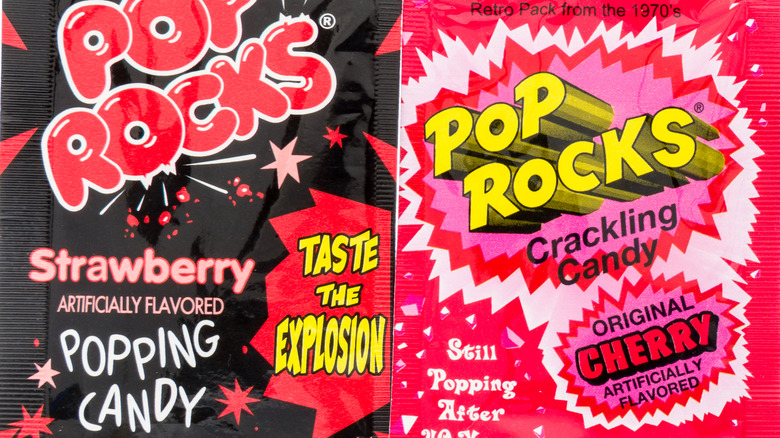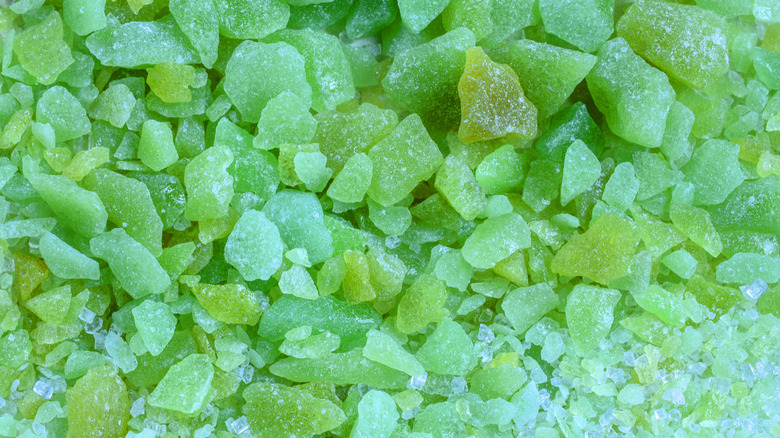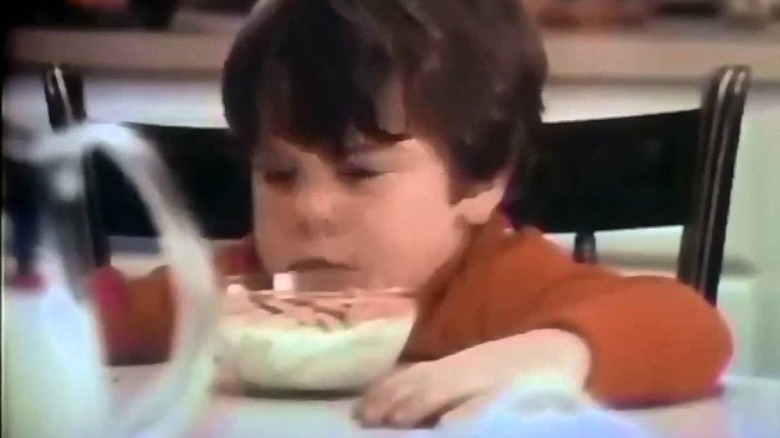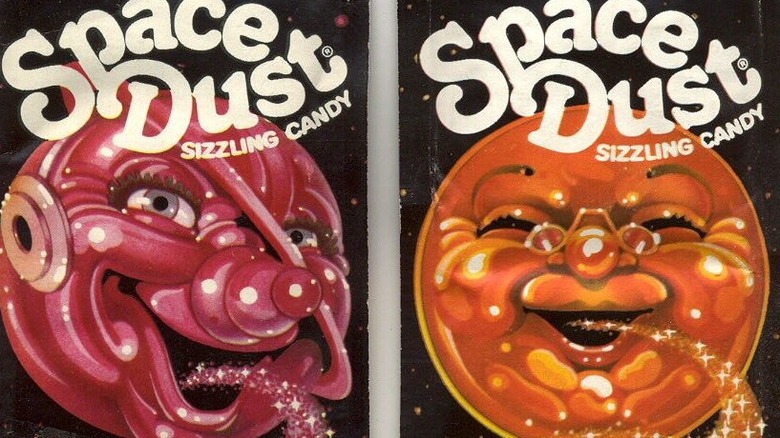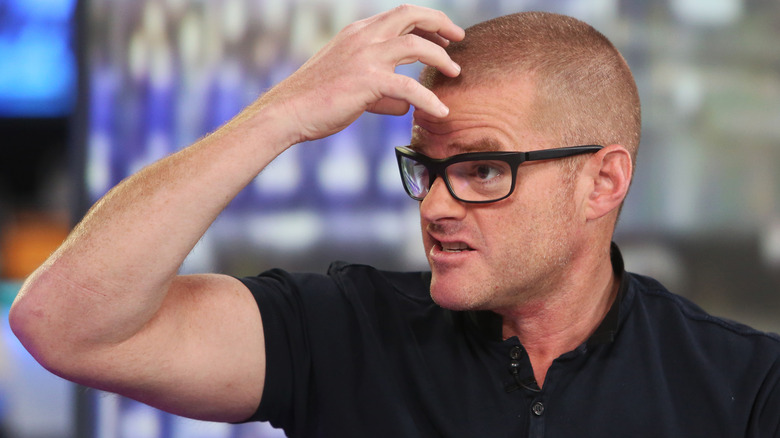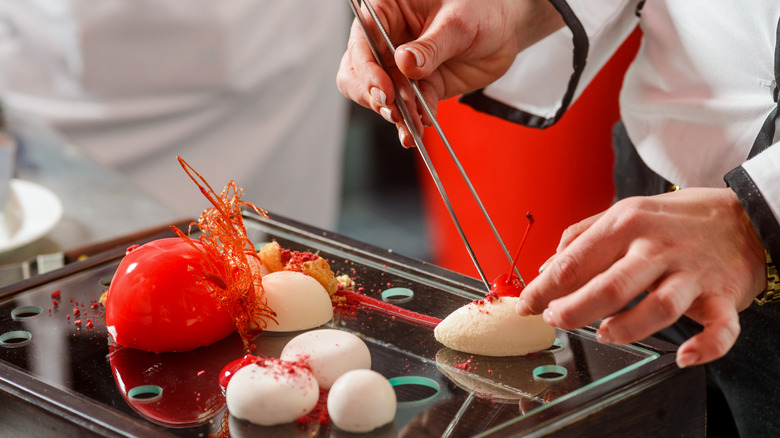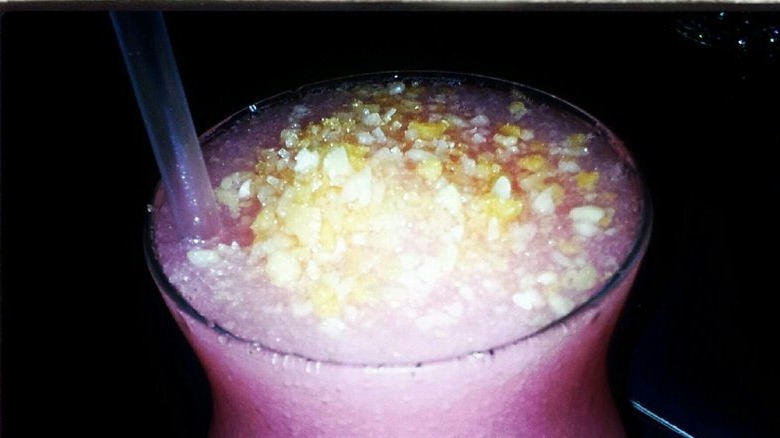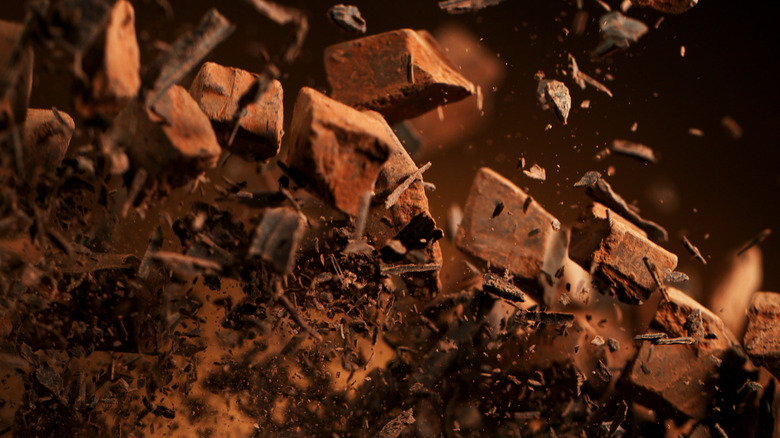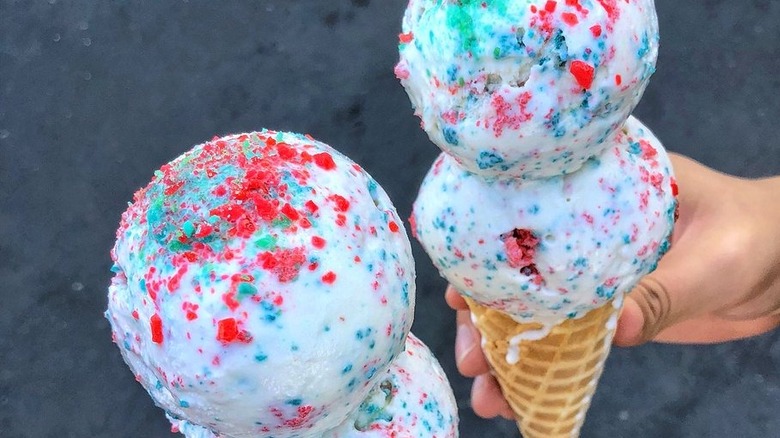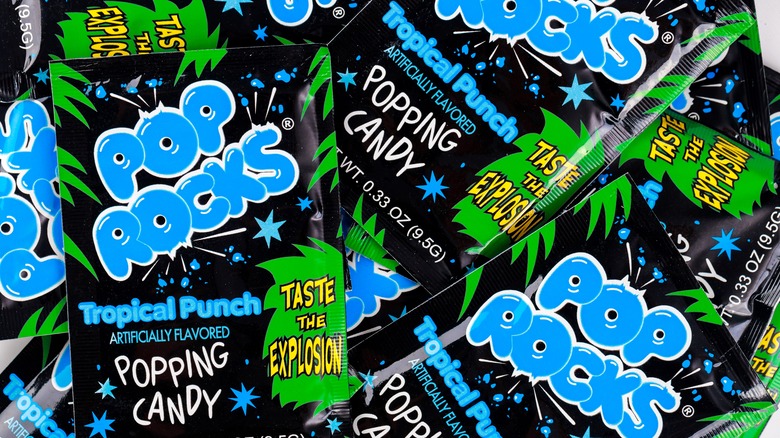The Untold Truth Of Popping Candy
When it comes to strange and exciting candy, perhaps none were as different or as innovative as Pop Rocks. Kids across the U.S. and the world would be wide-eyed with amazement as the sugary rocks fizzed and crackled on their tongues in an explosion of loud pops. The history of not only Pop Rocks, but the story of popping candy's evolution over the years, is one that captures the imagination. It involves a science experiment, an urban legend or two, and a reinvention by the culinary world, as well as popping candy companies leading the way in Spain and Turkey (via Austin Chronicle).
Pop Rocks was invented by accident in the '50s by a chemist at General Foods who was trying to create an instant carbonated soda. Six patents later, and Pop Rocks was officially launched in the '70s, along with a bubble-gum that popped called Increda Bubble. Called by one book "America's Revolutionary Candy", Pop Rocks may be the start, but it's not the end of the popping candy tale, which traverses the globe reaching into the kitchens of some of the world's most renowned chefs to being a favorite candy for kids and young-at-heart adults to this day. There's a lot to unpack when it comes to the untold truth of popping candy and for what was once a simple candy in a foil pack, with brightly colored, zany designs, the concept has really transformed, while still offering kids that magical fizzing feeling.
How does popping candy work?
There's no doubt that popping candy does exactly what the name suggests, creating a popping sensation in the mouth. Whether you put a few crystals on your tongue or tip a good amount into your mouth, the effect is instant every time. So how does popping candy work? Well, there's definitely not one formula, since brands vary, however, the concept is pretty much the same. The simplest way to describe popping candy is that it's made with sugar crystals and bubbles of carbon dioxide to make what's called gasified candy. General ingredients for popping candy are sugar, flavorings, lactose, and corn syrup.
In other words, there's a scientific reason behind that distinctive pop. The sugar is heated up, with the gas added, before the mixture is cooled down, causing it to break into pieces that have CO2 bubbles inside. To give you some idea of the process, the pressure under which the carbon dioxide is added is equivalent to atmospheric air pressure multiplied by 40. (via Science World).
What happens when popping candy is eaten is that the sugar dissolves due to the heat and the moisture inside the mouth, releasing the gas with a pop. If you want to investigate further, Chymsit has a Pop Rocks experiment to measure carbon dioxide. Alternatively, you can simply enjoy some sugary-tasting candy jumping around in your mouth.
There were rumors that popping candy killed Little Mikey
Part of the appeal of popping candy for kids may well have been the perceived danger of eating this explosive candy which undoubtedly came from myths that arose around the product. One of these debunked stories is that consuming Pop Rocks and soda will make your stomach explode, which it will not. The fact that there are various popping candy and soda experiments on YouTube demonstrates just how much this tale has passed down through generations since it was first told decades ago.
The urban legend was connected to a character in a Life Cereal commercial called Mikey, whom it was said had passed away after eating the candy with a soda. Where this idea came from is not clear, but what was certain is that child actor John Gilchrist was very much alive and after the advert aired in the late '70s, he would go on to star in another advertising campaign for the cereal brand as an adult. However, while young Mikey may have been safe, some parents were scared that the popping candy could harm their children, and an FDA Pop Rocks helpline was set up to assure parents that their kids wouldn't choke on the candy. However, a Thrillist feature does point out that the process of making the popping candy was dangerous, involving molten sugar and the sheer amount of pressure, and workers wore protective gear.
Why Space Dust became Cosmic Candy
Created by the same company, Space Dust was similar to Pop Rocks, except that the crystals were crushed and therefore resembled a powdery dust rather than rocks. Space Dust came in a variety of flavors such as grape, orange, and cherry. However, Space Dust as a brand name was not to last, primarily due to fears among adults that it was reminiscent of so-called angel dust or PCP, a hallucinogenic drug that was used in a powdered form. Parents worried that Space Dust may lead to drug use. In reaction to this, the company changed its name to Cosmic Candy.
Pop Rocks has also been called Pop Rocks Action Candy and there are, of course, other varieties such as super loud Fizz Wiz popping candy and Tango Popping Candy in apple, cherry, and orange flavors. Others include a brand called Volcano, including lychee, cola, green apple, and strawberry varieties. One YouTube review of a brand called Striking includes crackles into the microphone to create an ASMR effect. Sparx is yet another brand. Aftershocks Popping Candy comes in a spiky-shaped packet with two flavors to try, and one variety including gummy fruity fries to dip in the crystals. There's no doubt, however, that it was the early brands such as Pop Rocks, Space Dust, and Cosmic Candy that are still iconic names in the popping candy world.
A famous chef cooks with popping candy
Renowned British chef and culinary innovator, Heston Blumenthal is renowned for his interesting dishes along with his use of quirky ingredients and scientific techniques, in a style of cooking that is called molecular cuisine or molecular gastronomy which focuses on the science behind ingredients and their interactions. The head of The Fat Duck Group, and the three Michelin star The Fat Duck restaurant in England, it is perhaps little surprise that the kitchen maverick has also experimented with popping candy too. Waitrose supermarket stocked his chocolate and passion fruit cake with popping candy with the chef posting a recipe on his website on how to make the dessert with its explosive popping candy layer inside. The chefing wizard even has his own Heston brand of popping candy for sweet treats.
Meanwhile, an article in Big Hospitality notes that since the famous chef's use of the candy, other restaurants have also included it in their dishes, such as a pomegranate popping candy sorbet on the menu at the British chain of Italian restaurants, Zizzi. There is even a burger with popping candy that was served up at U.K. restaurant Revolution, suitably called the Hell Fire Fizz Bomb. Spanish chef and restaurateur, Ferran Adria, of the once open El Bulli, which was voted the best restaurant in the world many times has not only played around with popping candy in the kitchen but created his own line of Sparkys popping sugar designed for cooks.
Popping candy's been given a gourmet taste
Today, popping candy has been reinvented and given a gourmet overhaul, with many varieties more likely to be seen presented during a fancy dinner than eaten by kids running around the playground with a mouthful of sizzling candy. In fact, this new identity is light years away from the days of Space Dust, Cosmic Candy, and Pop Rocks. There are lots of gourmet-style popping candy varieties on the market, including Culinary Crystals which are described on the packet as, "customizable carbonated candy," because flavors can be added to them and they can be used in so many different ways.
Other fun varieties include a gourmet beer flavor that doesn't contain alcohol and Sosa copper chocolate-coated popping candy. Meanwhile, food writer, chef, and YouTube vlogger, Claire Saffitz also attempted to make gourmet popping candy. Described as "sparkling sugar," Terre Exotique is designed not just to eat but also use in gourmet dishes too from chocolate truffles to fruit salads, and also chocolate mousse. While chefs may love trying out new recipes with popping candy, with so many varieties on the market, there's nothing stopping cooks at home from trying out their own imaginative popping candy ideas and reinventing classic dishes, and having a blast along the way.
Popping candy can be used to make cocktails
While a classic margarita may have a salty rim, there are many cocktails and mocktails that have a sugary embellishment. However, you can really add a spark to a party drink by using popping candy around the rim of the glass. The popping candy is stuck to the edge of the glass by dipping it upside down into some syrup before dipping the rim into the candy. It seems there's no end to how popping candy can be used in interesting ways.
In one YouTube video, posted by Kubarz, a cosmopolitan cocktail is given a twist by being made with fairy floss and some popping candy sprinkled into the liquid. One article suggests dampening the rim of a glass with lemon juice, or using a small amount of caramel instead if the popping candy that is added clumps together. Kitchen Alchemy from Modernist Pantry suggests sprinkling some Culinary Crystals into a drink just as it's served at a dinner party as a fun experience for guests and is certainly a way to get a social event into the swing, with some laughter and excitement. It's a perfect way to inspire a feeling of celebration too, and bring a sparkle to any occasion and get everyone talking as they sip their fizzing drinks.
Popping chocolate for a sweet surprise
One popping candy trend is its use in chocolates and chocolate bars which includes luxury brands such as London's artisan du chocolate which offers a milk bar with popping candy using fine cocoa. Another interesting choice is Tony's Chocolonely white chocolate with freeze-dried raspberry and popping candy. The smoothness of any kind of chocolate, whether dark, milk, or white is the perfect complement to the fizzing sensation of popping candy. Meanwhile, even chocolate sprinkles come with a popping candy variety and can be used in many different ways to make a chocolate-lover's experience really pop.
Hammond's have come up with a unique bar of chocolate called SodaPOP which is cola-flavored chocolate that adds some fizz, as well as having fizzy popping candy added, too. There's also an Israeli brand, which is called Elite that incorporates the candy in a milk bar as well. Famed chocolatier, Oriol Balaguer, from Spain, who has won many awards, including accolades for his croissants, desserts, and gastronomy website, is renowned for his sophisticated-looking architectural chocolate masterpieces. However, being highly creative, he has also used popping candy which is one of the flavors of his signature chocolates that are fashioned in the style of cocoa pods. Other flavors include yuzu and Earl Grey tea.
Cooking desserts with popping candy
There's no end of possibility for popping candy in sweet culinary creations, whether the gourmet variety or retro-style. Beyond a celebrity chef and chocolate manufacturers adding some sparkle into recipes, there are lots of different dessert ideas using popping candy that have popped up online. These include a creme brulee served with a strawberry sorbet and the sugary crystals on top as well as a crackling topping on candy. These little rocks of sugary fizz have been added to ice cream, with one variety being a cotton-candy flavored ice cream with popping candy and topped with marshmallows and more.
Other ideas include brownies with popping candy. There really are so many ways that this candy can be turned into a versatile ingredient that adds an element of fun and surprise to many sweet dishes with a fizzing sensation. In fact, the largest manufacturer of its own patented popping candy, distributed to big companies as an ingredient is Hleks, based in Turkey. The candy is supplied to a variety of companies involved in making ice cream, chocolate, and cereal. It was two friends, studying in the U.K. in the '70s, who came up with a new way of making popping candy and patented their ideas in 1998 before creating a distribution network of more than 70 countries. The company makes Shoogy Boon, a cereal coated in chocolate with popping candy. They also make Surprise Dip, a lollipop with popping candy.
Popping candy continues to pop with fans worldwide
While you may think that Pop Rocks, Space Dust, and Cosmic Candy are all-American products, being such an iconic part of childhood in the late '70s and early '80s, the company base today is actually in Spain – Espacial S.A. In 1989, General Foods was combined into Kraft Foods and a license was given to the Barcelona-based business, with Espacial S.A. buying the product from Kraft. However, even though the Pop Rocks family is now European, Georgia is the main distribution center.
As well as selling Fiz Wiz, the Spanish company also makes a range of exciting candy products. These comprise of a gum called frizzy pazzy, Magic Gum which has popping candy in it, and sugar-free candies Olrait, as well as Peta Zetas popping candy, Two To One candy and toy combo, and, of course, the renowned Pop Rocks. Popping candy began its journey through innovation and it seems that with gourmet versions, experimental cooking that adds a popping candy crackle, and perhaps people's nostalgia it is set to continue to be not only a much-loved candy, but a must-have ingredient for home cooks, mixologists, and high-end chefs in the future who are having a great time and inspiring their creativity by bringing the fun back into food and drinks.
